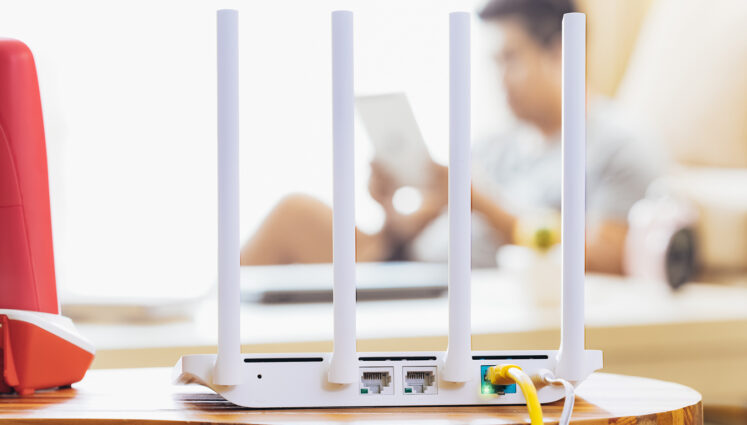
Ethernet vs. Wi-Fi
By Distributel
Confused about the best way to connect your devices to your router? In one corner we have Ethernet—that is, cables. In the other, we have Wi-Fi—that is, a semi-magical network that travels through the air. Which is better? Let’s break it down.
Speed
Ethernet is faster than Wi-Fi. That’s just a fact. But thanks to new technology, the difference isn’t very big at all. In fact, unless you’re transferring massive files very frequently, you’ll likely never notice. The current standard Ethernet cable, Cat6a, transfers up to 10 Gbps. The new standard Wi-Fi, Wi-Fi 6, transfers 9.6 Gbps. When it comes to speed, it’s basically a tie.
Latency
Where Ethernet has a real advantage is in the realm of latency. Latency is a type of delay in the information packets travelling through the network to you. For a more detailed explanation (and how to measure your latency), check out this post. In general, Ethernet connections have much lower latency. Why? Data has to jump through more hoops when it’s travelling via Wi-Fi than it does through Ethernet. Sometimes it screws up those jumps, and you end up with latency. When it comes to streaming TV or playing a video game, that latency may really bug you.
Ease of Setup
Wi-Fi is pretty easy to set up. You just plug a router into the modem, adjust the online settings, and then log into your network from anywhere it can reach. And if you have dead zones, you can fix them pretty easily too, with things like mesh Wi-Fi.
Setting up an Ethernet connection is only easy if your router happens to be near the device you want to connect. Is your router sitting right next to your TV on an entertainment centre? Great, it’ll be easy to run an Ethernet cable from one to the other and enjoy that low-latency streaming. If not, you’ll have to run cable through your walls, a task better left to professionals. If there are already Ethernet cables run through your walls, and connections between where your router is and where your intended device is, then great. If not, take a second look at that mesh Wi-Fi.
One other thing: if you happen to be in the process of building or renovating a house, get as many Cat6a Ethernet connections in as many rooms as you find feasible. Being able to plug into your network anywhere with ease is such a luxury.
Upgrading
One day, there will be a new Ethernet standard and a new Wi-Fi standard. How will you upgrade? When Wi-Fi 7 rolls around, you’ll buy a new Wi-Fi 7 router, plug it in, connect it to your modem, follow the setup wizard, and then reconnect all your devices. It’s a bit of a project, but ultimately easy.
When Ethernet rolls out Cat7 cables, it’ll be a different ball game. If there’s nothing in between your router and your device, all you’re doing is unplugging the old cable and plugging in the new one. If your Ethernet cable goes through a wall, guess what has to come out and what new cable has to go in? Yeah, that’s a much bigger, much more annoying project, potentially involving drywall dust and paint.
Security
Ethernet has better security than Wi-Fi in the sense that it’s harder to interrupt a signal going through hardware (in this case, a cable) than a signal going through the air.
With that fact pointed out, let’s point out another: in your household network, this won’t really matter. Updating quickly and often, using strong passwords, using a guest network, and practicing good online safety habits will be far more important to your network security than whether you choose Ethernet or Wi-Fi.
Unless you don’t use a Wi-Fi password, for some reason. But you’re not that foolish, are you?
Simple Answers: Which Devices Go with Which Technology?
So all things being equal, should you use Ethernet or Wi-Fi for your various devices? Well, if you can, connect your TV, gaming computer, and gaming console to your router via Ethernet. The low latency is ideal for these devices. For everything else, especially portable devices, Wi-Fi is more than sufficient (and necessary, given that your smartphone does not connect to Ethernet).
And the rest of your devices? Well, if you’re talking about a device that streams video, such as a security camera, it would be nice to connect via Ethernet. But as we’ve discussed, Wi-Fi is more than capable of doing the job. And everything else? Well, beyond video and gaming applications, there aren’t many devices that really need the lowest possible latency and marginally better speeds. If you can use both for different devices, great. If Ethernet just isn’t possible with your setup, remember that you can get great results with Wi-Fi 6 or mesh Wi-Fi. If you’re still having trouble, be sure to optimize your internet network.
